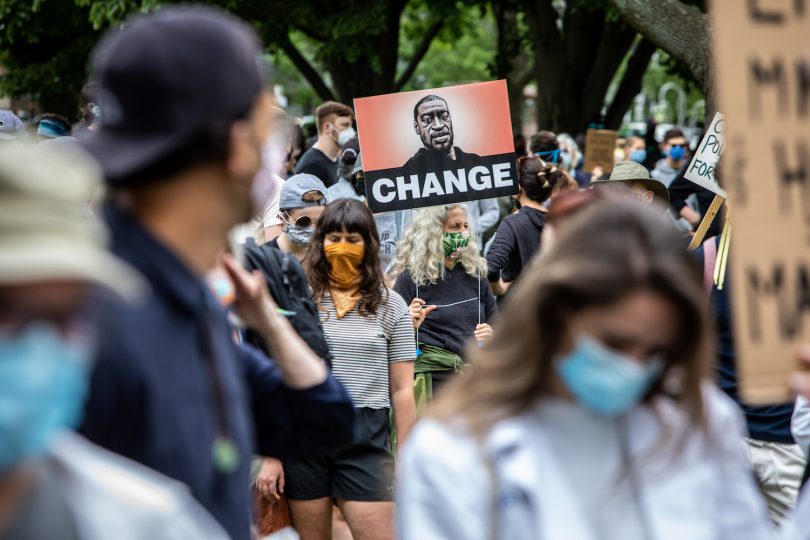For centuries, systemic and structural racism in the United States constrained and prevented opportunities for Black Americans and other communities of color to live long, healthier and prosperous lives.
Since George Floyd became another victim of racism and injustice, the world is focused on this renewed fight for civil rights and justice. Understandably, organizations — like many of our clients and partners — that are invested in the mission of improving lives and advocating for social change want to show support.
These organizations no longer want to be neutral in this fight against inequities and injustices. They want to contribute and support the conversation and reflect the best standards of diversity, equity and inclusion (DEI) in their communications. But this is a complicated, layered conversation with a long traumatic history and generations of impacted communities. How can communicators help their organizations find the best messaging, strategies and tactics to contribute to this conversation?
It’s important to align your organization’s efforts to engage in the conversation and improve your audience’s comprehension and understanding of your position on racial justice issues, using the following components:
- Align key messaging to DEI components in your organization’s mission and values. This alignment will strengthen your communications and boost credibility with your external and internal audiences. Fair warning: If your mission and values do not reflect DEI, then it’s best to stay out of the Black Lives Matter conversation and start reflecting and reworking your mission and values as an organization to better represent DEI considerations.
- Be authentic. Authenticity means ensuring that your organization’s DEI structure and actions within the organization match your external DEI messaging. Authenticity builds credibility. It’s important to state your organization’s DEI shortfalls related to racial equity as well as action plans to address them.
- Be transparent. Transparency means openly sharing the strengths, weaknesses, opportunities and threats when communicating about DEI-related concerns. Transparent messaging reflects where you are now and shares actionable steps to be taken. Part of transparency is sticking to what you know and value.
Once you follow that DEI engagement formula, your organization should also consider these approaches for message and strategy development:
- Be thoughtful and not just reactive. Rushing to respond may hinder the effectiveness of your messaging and limit opportunities to identify the best communication strategies and tactics to engage in the racial justice dialogue.
- Listen first and conduct background research before communicating. Before engaging in ongoing conversations — especially on social media platforms with hashtags — listen first and gain as much context and background information as possible before releasing official statements and posting on social media. Make sure to reference as many available primary sources as you can before communicating.
- Be explicit and direct in your messaging. Don’t be afraid to make declarative statements like “Black lives matter” or “Dismantle systemic racism” if that is what aligns to the mission and values of your organizations. Don’t bury the lede. Feature key messages in content by reducing nuances and poetic language and keeping your DEI messaging clear, simple and concise.
- Commit to action and don’t just communicate support. Audiences, especially in communities of color, are no longer looking for support. They want action. Communicators should enhance their statements of support with clear commitments for taking DEI-related actions and policy changes as an organization.
- Communicate externally and internally with similar messaging. Both external and internal audiences should be on the same page regarding where and why your organization is taking a stand on racial equity and justice issues. By sharing the same messaging within and outside of your organization, communicators can ensure consistency and a similar understanding across all audiences.
- Avoid response repetition. George Floyd’s death is not the first — and unfortunately, may not be the last — casualty of these inequities. Key messages that reflect organizational mission, values and actions can be repeated; however, the context and delivery of these messages should be customized to reflect the specific moment and feel timely to audiences.
- Provide consistent messaging on all communication channels. When delivering statements or announcements, make sure to share each one in its entirety on each communication channel to ensure that the organization’s position is not misconstrued or misunderstood due to editing.
- Invite your audience — external and internal — to provide feedback. Create channels to receive and evaluate feedback on your DEI engagement. Use these audience insights to inform adjustments and action steps needed to hone and improve future conversations on racial justice.
Today, we are communicating in one moment of a long-term movement for equity and justice. We need to pace ourselves while leveraging the increased interest and action by the public in addressing systemic and structural racism.
Actions speak louder than words. Today, the world is demanding action and valuing diversity, equity and inclusion. If we align our actions to our organization’s mission and values and deliver our words with authenticity and transparency, then we can create real change and keep this movement going forward.
If we lack those elements, then it’s wise to stay out of the conversation, find other ways to support the racial justice movement and, more important, start an internal dialogue about how your organization can better reflect DEI elements.
PRSA member Crystal Borde is vice president and diversity + inclusion practice lead at Vanguard Communications in Washington, D.C. This is a modified version of a post that first appeared on Vanguard’s In Practice blog.
Photo credit: maverick pictures








This article discusses strategies organizations can use to lead blunt, honest conversations on race equity. I want to contribute and support the conversation and reflect the best standards of diversity.